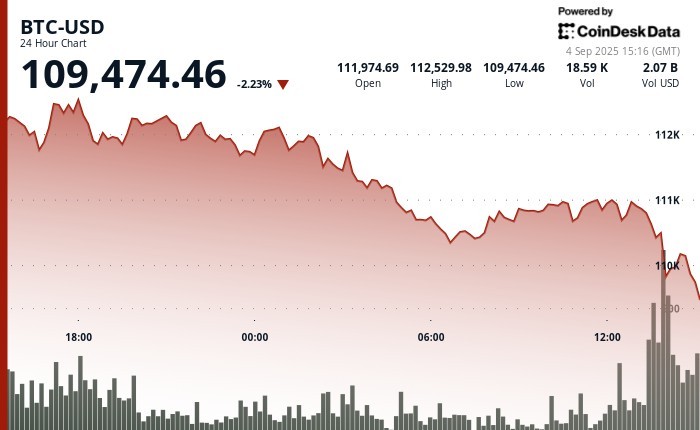Bitcoin Retreats Below $110,000 as Market Rally Falters, Experts Warn of Further Declines
Recent Price Action Deflates Optimism as September Trading Begins
Bitcoin’s modest recovery effort stalled abruptly on Thursday as the flagship cryptocurrency slipped below the $110,000 threshold, prompting analysts to caution that a deeper market correction could be imminent. After briefly climbing to $112,600 on Wednesday, Bitcoin surrendered half its recent gains, settling at $109,500—a 2.2% decline over 24 hours. The retracement raises questions about market momentum as the asset enters what has historically been one of its most challenging calendar months.
The broader cryptocurrency ecosystem reflected this downward pressure, with Ethereum (ETH), Solana (SOL), and Cardano (ADA) all recording losses exceeding 3% during the same period. This synchronized retreat suggests a market-wide reassessment of valuations following Bitcoin’s historic run to $123,640 in August. The current price represents the third consecutive week of retracement from that all-time high, according to analysis from Bitfinex, establishing a pattern that has caught the attention of institutional and retail investors alike.
Digital asset treasury stocks—often viewed as proxies for cryptocurrency market sentiment—experienced even more pronounced declines. MicroStrategy (MSTR), which maintains the largest corporate Bitcoin holdings, dropped 3.2%, extending its losses to 30% since July. Japan-based MetaPlanet has fallen 60% from its June peak, while KindlyMD continued its precipitous decline, losing another 9% and bringing its total drawdown to 75% since mid-August. Ethereum-focused investment vehicles BitMine and SharpLink Gaming weren’t spared either, with both shedding between 8% and 9% of their value.
Historical Patterns and Competing Assets Shape Market Outlook
September’s reputation as a historically weak period for Bitcoin looms large in the minds of market participants. This seasonal pattern, coupled with gold’s remarkable performance—breaking above $3,500 and establishing new all-time highs—creates a challenging environment for risk assets. Gold’s resurgence may be drawing capital away from the cryptocurrency space as investors seek safer stores of value amid ongoing economic uncertainty.
“We’re seeing a classic flight to established safe havens,” remarked a senior market analyst at a leading cryptocurrency exchange who requested anonymity. “When gold breaks out to record highs after consolidating for months, it often creates headwinds for alternative stores of value like Bitcoin. This rotation between asset classes is particularly pronounced during periods of market stress or when investors are reassessing risk exposures.”
The technical picture reveals important support levels that market watchers are monitoring closely. Bitfinex analysts identified the short-term holder realized price—essentially the average cost basis for newer Bitcoin investors—at approximately $108,900. This level sits precariously close to Bitcoin’s current trading price, suggesting that if breached, it could trigger additional selling pressure. Should this support fail to hold, Bitfinex projects that a denser supply cluster between $93,000 and $95,000 would likely establish a more substantial floor, representing a roughly 23% correction from the recent peak.
Potential Correction Magnitude Debated Among Market Strategists
Historical precedent suggests the current pullback may be approaching typical limits. According to the Bitfinex report, bull market corrections in Bitcoin have averaged approximately 17% from peak to trough. With Bitcoin currently down about 11% from its all-time high, some analysts believe the majority of the retracement may have already occurred. However, the failure of key support levels could accelerate the decline toward the identified supply cluster in the low $90,000s.
Joel Kruger, market strategist at LMAX Group, offers a more optimistic perspective. He notes that September has traditionally functioned as a consolidation period before stronger performance in the year’s final quarter. “While historical patterns suggest caution in September, several potentially supportive factors could make this year’s correction shallower than typical,” Kruger explained. He pointed to continuing ETF inflows, corporate treasury allocations to Bitcoin, and an increasingly favorable regulatory environment as potential catalysts that could limit downside and set the stage for a strong year-end rally.
The options market appears less convinced of a near-term recovery. Data from major derivatives exchanges indicates a tilt toward bearish positioning ahead of Friday’s significant options expiry, suggesting that professional traders are hedging against further price declines. This cautious stance reflects the uncertainty surrounding Bitcoin’s immediate trajectory as it navigates the historically challenging September trading period.
Broader Market Implications and Future Outlook
The current pullback must be viewed within the context of Bitcoin’s remarkable performance in 2024. Despite the recent weakness, Bitcoin remains up substantially year-to-date, having more than doubled in value since January. This perspective has some long-term investors viewing the current correction as a healthy consolidation rather than the beginning of a more significant downturn.
“What we’re witnessing is a natural cooling-off period following an incredibly strong rally,” commented a cryptocurrency fund manager with over $500 million in assets under management. “Markets rarely move in straight lines, and periods of consolidation or retracement are essential for establishing sustainable bull markets. The key metrics we’re watching—including network activity, institutional involvement, and on-chain data—continue to show robust fundamentals despite the price correction.”
Institutional participation remains a critical factor for Bitcoin’s next directional move. The launch of spot Bitcoin ETFs earlier this year has provided traditional financial institutions with regulated access to the asset class, resulting in significant inflows. However, the pace of these inflows has moderated in recent weeks, coinciding with Bitcoin’s price retreat. Whether these vehicles resume their strong accumulation patterns could significantly influence market sentiment heading into the fourth quarter.
As Bitcoin navigates this period of uncertainty, market participants are closely monitoring several key indicators: exchange flows, mining network health, derivatives market positioning, and macroeconomic developments that could affect risk appetite. The cryptocurrency’s response to the current support level around $108,900 will likely prove decisive in determining whether the correction remains within the typical bull market range or extends toward the more substantial support zone identified in the low $90,000s.
In this evolving landscape, one certainty remains: Bitcoin’s journey continues to attract unprecedented attention from both traditional finance and the broader public, underscoring its transformation from a niche technological experiment to a globally significant financial asset whose movements reverberate throughout the investment world.















